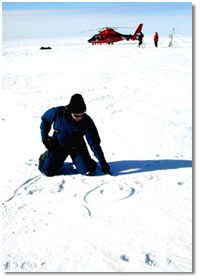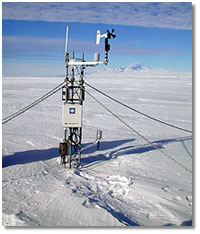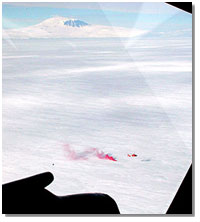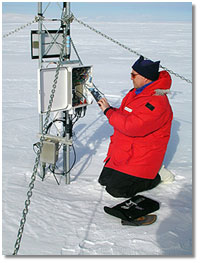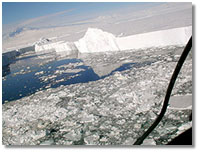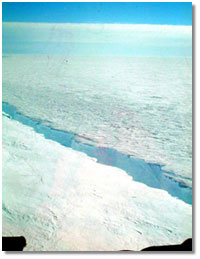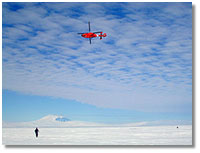 |
|
|
 |
||
|
|||||||||||||
|
Enormous Iceberg May Be in Its Death Throes
|
|
For perhaps the last time, a researcher has visited iceberg B-15A, an enormous fragment of ice that broke away from Antarctica's Ross Ice Shelf in March 2000. During a one-hour visit on Jan. 29 (New Zealand time), Douglas MacAyeal of the University of Chicago upgraded the software of an automated weather station on the enormous piece of ice that helps track the iceberg's position and reports on the microclimate of the ice surface. MacAyeal's work is supported by the National Science Foundation (NSF) through the U.S. Antarctic Program. MacAyeal and other researchers placed weather stations on the iceberg a year ago. This year, MacAyeal flew twice to B-15A on U.S. Coast Guard helicopters to update the software that allows the weather stations to transmit data and to adjust the sensors that measure wind speed. MacAyeal said that collisions between B-15A and a much smaller, though still impressive, iceberg, dubbed C-16, have begun the process of breaking up the bigger berg. He suspects B-15A will crumble into pieces and drift northward away from McMurdo Sound when summer returns to Antarctica, almost a year from now. "B-15A is ripe" for a breakup, he said. "But it's a 'wait and-see' sort of thing." During the flights to and from the iceberg from McMurdo Station, the main NSF research station in Antarctica, MacAyeal pointed out enormous cracks developing on the berg's surface. He also noted areas where the two icebergs have ground together, generating as much as 4,000 pounds per square inch of pressure. A zone between the two bergs features both narrow ice canyons 30 meters (100 feet) deep and spacious bays, in which icebergs that ordinarily would be thought of as colossal seem insignificant in comparison with their larger neighbors. MacAyeal noted that few human eyes have seen such phenomena. The collisions, he said, accelerate the breakup of both bergs and the movement of the remaining fragments out to sea. By observing B-15A and C-16, "we've learned that collisions of this nature provide a force that helps propel an iceberg on its track," MacAyeal said. He added that it is possible that scientists may be observing for the first time a cycle in which portions of the Ross Ice Shelf break off and fall into the sea as giant icebergs. The National Ice Center, in Suitland, Md., reported that a new iceberg, dubbed C-17, broke away from the Ross Shelf on Feb. 7. C17, which broke away from the Matusevich Glacier, is estimated to be 58 square miles in area, or roughly the size of Manhattan Island.
|
Larger versions (Total Size: 7MB) of all images from this document
|
![]()
For information about how the icebergs have affected Antarctic penguin colonies, see http://www.nsf.gov/od/lpa/news/press/01/pr01108.htm
Editors: B-roll from the iceberg, including an interview with MacAyeal, will be available via C-band satellite; Thursday and Friday, from 1-1:15 p.m. on Telstar 5, Transponder 16, DL 4020. For digital photographs from B-15A contact Peter West, (703) 292-8070 / pwest@nsf.gov
|
|
